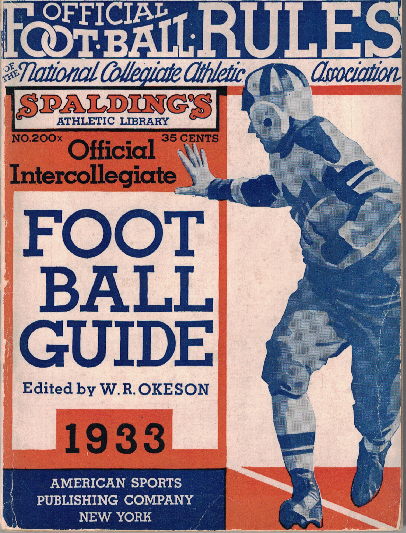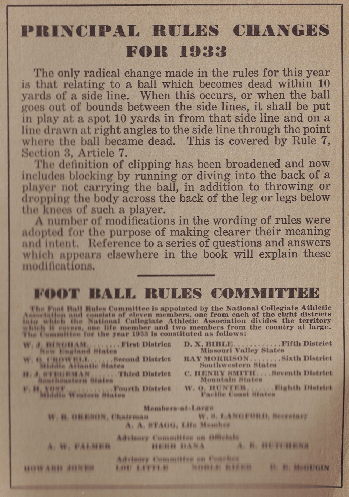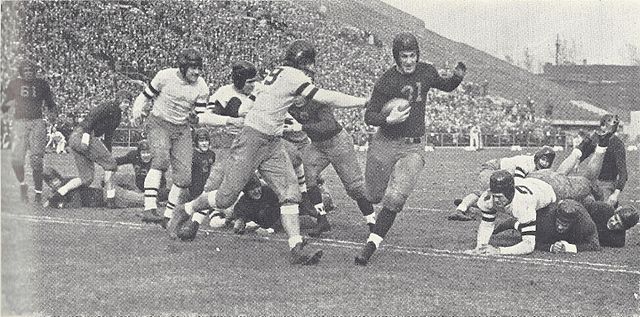Our year-by-year look at the history of American football takes us to the 1933 College Football season. We dive into the top teams, and rules revisions of that season and find out who the Champion was as determined by the experts.
Football History Rewind Part 72
Rules Revisions for 1933 Football

1933 Spalding Official Collegiate Football Guide and Rulesbook Cover.
The biggest College Football rule revision for the 1933 season was a simple field marking. Data had been collected representing that an average of fourteen plays per game were wasted by offenses trying to move into a better position on the field when the previous plays had finished beyond or near the sideline. The prior rule stated that the ball would be spotted at the point it became dead on the previous play. For a play that finished with the ball carrier going out of bounds, the center would be snapping the ball very close to the sideline. Defenses had the advantage of knowing the direction of the next play.
To correct this the rules committee of the NCAA decided the ball would be moved to the hash mark for any dead ball between the mark and sideline or out-of-bounds play.

Dickinson System Champ of 1933

Image is courtesy of Wikimedia Commons of Everhardus runs for touchdown at Chicago, 1933
The Dickinson System was still the prominent way of determining a National Champion in college football in 1933, as the top Dickinson scoring team would receive the coveted Knute Rockne Memorial Trophy.
The Michigan Wolverines were the " Knute " repeat winners with their stellar 7-0-1 record. The tie was against an undefeated Minnesota Golden Gophers team with about as many ties as they did wins that year (4-0-4). The Dickinson System was not the most trusted way of looking back to find the top team in the country, though. We saw that in the previous season, though the Wolverines were the top points getters in Dickinson, the reflection of experts trying to determine a retro look at rankings and National Champions gave the nod for 1932 to the USC Trojans, who killed the Pitt Panthers in the Rose Bowl game.
Michigan in the 1933 season, was a legitimate contender for the crown after so many seasons in the previous three decades that they were a distant second to a more logical choice. Once again, the Big Nine's staunch position did not permit its teams to play in the postseason, so the Wolverines could not accept a bid to the Rose Bowl that year. This created an opportunity for a new team from the East to head to Pasadena at New Years.
1934 Rose Bowl
The Columbia Lions would earn the rare treat of traveling to Pasadena from the East to play against a strong Stanford program.
Stanford was undefeated, while the Lions had suffered a single loss on the season to a rival, Fritz Crisler's Princeton Tigers. The Tigers declined the post-season game invite to keep with the school's focus on academia over athletics. Columbia, as underdogs, put together a bold defensive scheme under the direction of Coach Lou Little and, on a rain-soaked field, knocked off the Indians 7-0.
You can learn more about the 1934 Rose Bowl with this:
20th Rose Bowl Game
The Columbia Lions faced the Stanford Indians in the 20th edition of the Rose Bowl Game played in January of 1934.The 1933 College Football Season unfolds
Jock Sutherland's Pitt Panthers were riding high once again in 1933. Pittsburgh rattled of impressive wins against an 8-1 Nebraska team by the score of 6-0 and then blanked a 10-1 Duquesne with a final score of 7-0. The Panthers downfall was the 7-3 upset loss they suffered at the hands of Minnesota.
The Nebraska Cornhuskers were a powerhouse in 1933 as they overcame almost everyone they faced. That "almost" was at the hands of a 6-0 loss to Pitt. The Huskers other games of the close variety in 1933 were when they defeated a couple of top teams (5-3) Iowa by the close score of 7-6 and the (6-2-2) Oregon State blanking 22-0.
The Princeton Tigers went 9-0 on the season, including the previously mentioned Columbia. Fritz Crisler's Princeton eleven dismantled a very good Columbia squad by the score of 20-0 that year for the Lions only setback.
The Tigers shut out seven of nine opponents on the season, and outscored all opponents by a total of 217 to 8. The eight points were surrendered over the final two games as Rutgers managed 6 at Princeton on November 25 while the Yale Bulldogs pinned a safety on Princeton in the Yale Bowl in the season finale.






